Multi-component quantitative and feed-forward neural network for pattern classification of raw and wine-processed Corni Fructus
Yu Liu,Ying-Fang Cui,Dan-Dan Shi,Shu-Li Man*,Xia Li,Wen-Yuan Gao
1State Key Laboratory of Food Nutrition and Safety/Key Laboratory of Industrial Microbiology, Ministry of Education/Tianjin Key Laboratory of Industry Microbiology/National and Local United Engineering Lab of Metabolic Control Fermentation Technology/China International Science and Technology Cooperation Base of Food Nutrition,Safety and Medicinal Chemistry/College of Biotechnology,Tianjin University of Science&Technology,Tianjin 300457,China.2Tianjin Key Laboratory for Modern Drug Delivery&High-Efficiency,School of Pharmaceutical Science and Technology,Tianjin University,Tianjin 300072,China.
Abstract
Keywords: Cornus officinalis Sieb. et Zucc.; quality evaluation; fingerprints; processing mechanism; feedforward neural network
Background
Corni Fructus(cornus) as a homology of medicine and food herb is derived from the mature sarcocarp ofCornus officinalisSieb. et Zucc.As a traditional Chinese medicine(TCM),cornus has been recorded for more than 2,000 years and widely utilized in clinical prescription [1,2]. There are two types of medical cornus based on different processing methods. The raw cornus(RC) is gained directly from dried mature sarcocarp, while wine-prepared cornus (WPC) is obtained by steaming the RC pre-steeped in wine which enhanced the effect of tonifying “liver” and “kidney”. Phytochemical researches indicated that the cornus enriched polysaccharides, polyphenols, iridoid glycosides, organic acids, amino acids and minerals, etc. [3, 4]. In addition, modern pharmacological studies pointed that cornus owned bioactivities of antioxidant, hypoglycemic, anti-bacterial,anti-inflammatory, neuroprotection, hypolipidemic and anti-obesity effects, etc. [5, 6]. Due to various climate and different processing methods, the region may be primary factor which directly affect their quality. Meanwhile, the misjudgment of source would cause confusion for consumers. In addition, it’s not clear for the alterative compounds and the alterative process during wine-processing.
Multi-component determination is generally regarded as a gold standard for evaluating the quality of TCM.The content of loganin and morroniside should be more than 1.2% in cornus according to version 2020 of theChinese Pharmacopoeiareported. The content of oleanolic acid, ursolic acid and sweroside, morroniside and loganin were determined by high performance liquid chromatography(HPLC)-evaporative light scattering detection and HPLC-ultraviolet,which improved the quality evaluation of cornus[7].The strategy that combined the quantitative analysis of multi-components by single marker with charged aerosol detection had certain advantages for the quantification of multi-components. This developed method could be a reliable and superior means for the multi-component quantitative analysis of Qishen Yiqi dripping pills (China Food and Drug Administration approval number: Z20030139) [8]. Besides multi-component determination analysis, fingerprint analysis is also an effective method based on comprehensively reflecting the complex compositions to evaluate quality of TCM [9]. For example, fingerprint has provided a scientific standard for the quality evaluation ofCitri Reticulatae Pericarpium[10]. A comprehensive method combined fingerprint and multi-component quantitative analysis was applied for quality evaluation of Wushe Zhiyang pills (China Food and Drug Administration approval number: Z44020044), which provided a feasible and efficient strategy to improve the overall quality consistency of TCM formulae[11].
Artificial neural network (ANN) is a practical and powerful pattern classification tool with excellent nonlinear system modeling,self-learning, and self-adaptive capabilities [12]. ANN is derived from the attempts to model the structure and functioning of biological nervous systems and can be employed to solve problems of prediction,classification or control in medicine [13]. The back propagation ANN model ofOphiopogonis Radixpolysaccharide precipitation was established to enhance the future control system design [14]. In this study, in order to improve the quality evaluation and distinguish sources of cornus, 21 batches of RC from 5 regions and 62 batches of WPC from 7 regions were analyzed by a satisfactory HPLC method.Reference fingerprint of RC and WPC were established to calculate the similarity among samples. The feed-forward neural network (FFNN)for RC and WPC were created to pattern classification of samples regions.
Methods
Chemicals and materials
The purity of all reference standards were large than 98%. Gallic acid(M0509AS), morroniside (N0418AS), 5-h ydroxymethylfurfural(5-HMF) (N1010AS), protocatechuic acid (J1001AS) and loganin(N0516AS) were purchased from Meilunbio (Liaoning, China).Sweroside (200108) and cornuside I (200317) were obtained from Ronghe (Shanghai, China). Ultrapure water was prepared using a Milli-Q purification system (Millipore, Bedford, MA, USA).Acetonitrile (HPLC grade) was from Merck (Darmstadt, Germany).Formic acid (HPLC grade) was bought from Fisher Scientific(Waltham, MA, USA). Other chemicals and solvents were analytical reagent grade. 21 batches of RC and 62 batches of WPC were collected(Table 1) from Shannxi, Shandong, Henan, Shanxi, Zhejiang, Anhui and Sichuan of China and authenticated by Prof. Wen-Yuan Gao of Tianjin University.
Solution preparation
Reference standards gallic acid, 5-HMF, protocatechuic acid,morroniside, sweroside, loganin and cornuside I were dissolved by methanol as 1 mg/mL stock solution respectively and different gradient mixed reference solution were prepared from diluent stock solution (Figure 1).
RC and WPC powder (60 mesh, 1 g) was sonicated in 250 mL of 80% methanol for 45 min at 20 °C. The filtrate was centrifuged at 8,000 r/min for 5 min and supernatant was filtered through a membrane filter (0.22 µm). Each sample was extracted 3 times in parallel and all solutions were stored at 4 °C until analysis.
Chromatographic analysis
The chromatographic analysis was accomplished on Agilent 1220 HPLC instrument (Santa Clara, CA, USA) which equipped with ultraviolet detector. The separation was carried out on Baseline C18(250 × 4.6 mm inner diameter (I.D.), 5 µm) column. The mobile phase was composed of 0.1% formic acid-water (A) and acetonitrile(B). The gradient elution procedure was as follows: 0-15 min, 2%-4%(B); 15-50 min, 4%-16% (B); 50-57 min, 16%-18% (B); 57-67 min,18%-25% (B); 67-75 min, 25%-98% (B); 75-82 min, 2% (B) at 1 mL/min. The column temperature was 30 °C and detection wavelength was set at 260 nm. The sample injection volume was 10µL.
Method validation
The HPLC method was validated for precision, repeatability, stability,recovery and linear. The RC01 sample solution was injected continuously for six times to evaluate precision. The six independent sample solutions from RC01 were employed to assess repeatability.Stability was tested by the RC01 sample solution at 0, 2, 4, 8, 12 and 24 h. The recovery was tested by using samples spiked with the mixed standard solution. The linear was evaluated by injecting different gradient mixed reference solution. The relative standard deviation of retention time and peak area (PA) should be less than 3% and R2of linear should be larger than 0.9999 which indicated superior method validation [15].
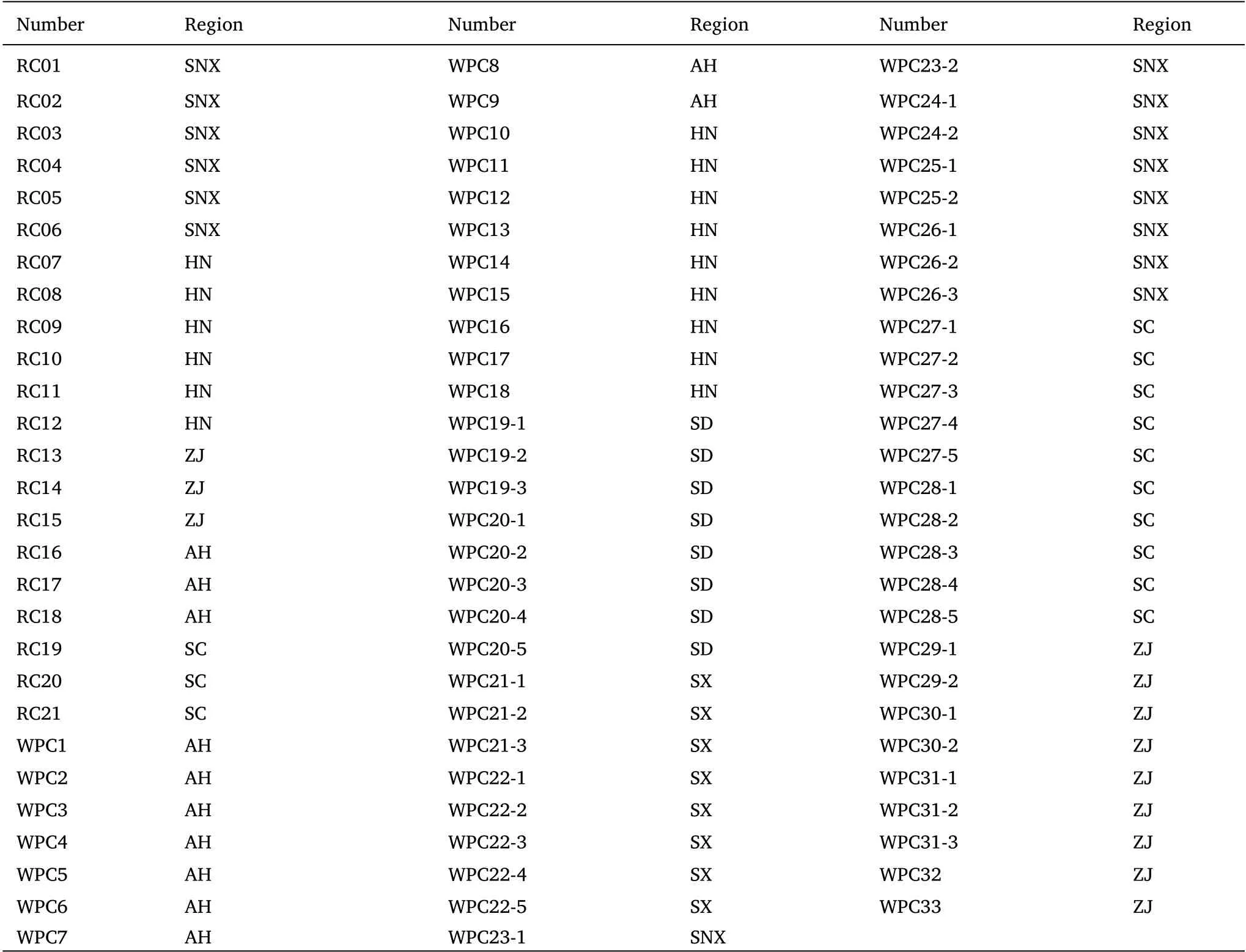
Table 1 Sample collection information
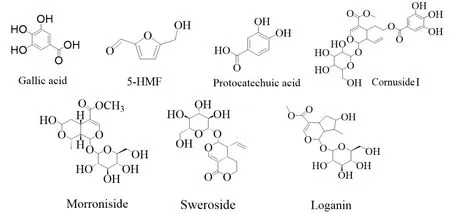
Figure 1 The structure of seven standards
Generation of reference fingerprint
The reference fingerprint chromatogram was generated by professional software Similarity Evaluation System for Chromatographic Fingerprint of TCM (version 2012A). Meanwhile,the fingerprint similarities were calculated among reference fingerprint and samples.
Classification scheme of FFNN
Based on content of 7 common peaks which originated from optimized fingerprint, three-layer FFNN architecture (7-8-5 for RC and 7-8-7 for WPC) was established by the online “Wu Kong” platform(https://omicsolution.org/wkomics/main/). The input layer was set to 7 nodes which corresponded 7 common peaks. A hidden layer contained 8 nodes after consideration of website pressure and preliminary comparison. The output layer consisted of 5 nodes for RC and 7 nodes for WPC that represented the number of regions. In order to avoid dramatic diversity of PAs and strengthen the classified borders among intra-species samples, the raw data was pre-processed by total intensity normalization as training set. The activation function was realized by website embedded log sigmoid (input and hidden layer). The performance of FFNN learning classifier was evaluated by four parameters: specificity, sensitivity, accuracy and area under curve (AUC) of Receiver operating characteristic curve. It was noted that only training result was provided in this study due to limitation of samples numbers. The final structure of FFNN with 8 hidden layers was shown in Figure 2.
Data analysis
Statistical evaluation was calculated by SPSS 26.0 software (version 26.0, IBM Corp., Armonk, NY, USA). Significant difference analysis was performed using an analysis of variance with Duncan’s test, andP< 0.05 was considered to be statistically significant. Data was expressed as the mean ± standard deviation using triplicate measurements. The chromatographic fingerprints of samples were established via the Similarity Evaluation System for Chromatographic Fingerprint of TCM (2012).
Results and discussion
Optimization for HPLC analysis conditions
The chromatographic conditions were essential for separation of compositions in sample. In the experiment, the mobile phase, gradient elution condition, chromatographic column and detection wavelength were optimized to develop a satisfactory HPLC method. 0.1% formic acid-water and acetonitrile performed better separation and peak shape than water-methanol and water-acetonitrile did. The detection wavelength was set at 260 nm. Baseline C18 column (250 × 4.6 mm inner diameter (I.D.), 5 µm) achieved appropriate resolution and peak symmetry than Kromasil 100-5-C18 (250 × 4.6 mm inner diameter(I.D.), 5 µm) column did. The chromatogram of standards, RC01 and WPC23-1 were shown in Figure 3, respectively.
Methodological evaluation
The methodological evaluation was employed to ensure the accuracy,reproducibility, reliability and durability of HPLC method. In the present study, the linearity and relative standard deviation of precision, repeatability, recovery and sample stability were shown in Supplementary Table S1. Linear correlation coefficients (R2= 0.9999)was excellent within the studied range. Relative standard deviation values of retention time and PA were used to estimate precision,stability, repeatability and recovery. All data were lower than 3.0%which indicated the acceptable precision, repeatability, recovery and sample stability. All in all, methodological evaluation for HPLC analysis was satisfactory which ensured the authoritative of the follow-up analysis in this study.
Quantification of seven components
As shown in Supplementary Table S2, the optimized HPLC method was used to quantify gallic acid, 5-HMF, protocatechuic acid,morroniside, sweroside, loganin and cornuside I in all batches of samples. The content of 7 compounds in RC samples performed great variation which indicated that the external environment may influence the quality of RC. Among these compounds, the content of morroniside and loganin was the highest in all origins that ranged from 9.45 µg/mg to 16.3 µg/mg and 6.64 µg/mg to 13.7 µg/mg,respectively. Interestingly, morroniside and loganin were recorded as authoritative markers to assess RC quality in version 2020 of theChinese Pharmacopoeia. In contrast, protocatechuic acid performed the lowest content in all samples. The content of sweroside in RC from Henan Province (0.83 µg/mg-1.39 µg/mg) and Zhejiang (0.64µg/mg-1.17 µg/mg) was greater than other origins. However, the content of 5-HMF from Zhejiang (1.84 µg/mg-2.79 µg/mg) was lower than that of the other origins. Cornuside I (1.11 µg/mg-2.45 µg/mg)was the most massive in Shannxi Province and gallic acid (0.43µg/mg-0.82 µg/mg) was the highest in Sichuan Province.
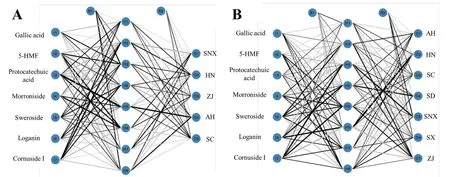
Figure 2 The topology of FFNN for RC (A) and WPC (B). I, H, O and B represented input layer, hidden layer, output layer and intercept respectively. The black line was positive value and grey line was negative value. The thickness of the line was positively with weight. FFNN,feed-forward neural network; RC, raw cornus; WPC, wine-prepared cornus; 5-HMF, 5-hydroxymethylfurfural; AH, Anhui Province; HN, Henan Province; SC, Sichuan Province; SD, Shandong Province; SNX, Shannxi Province; SX, Shanxi Province; ZJ, Zhejiang Province.
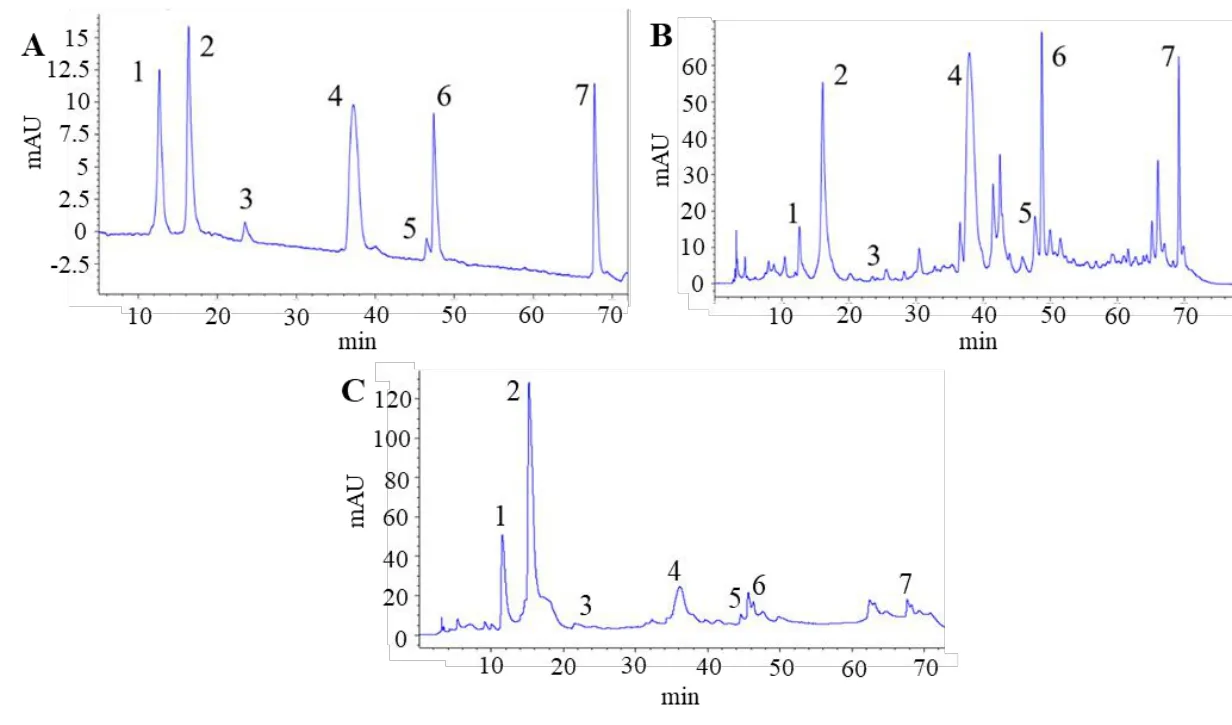
Figure 3 The chromatogram of mixed standards (A), RC (B) and WPC sample (C) at 260 nm. The number 1, 2, 3, 4, 5, 6 and 7 represented gallic acid,5-HMF,protocatechuic acid,morroniside,sweroside,loganin and cornuside I, respectively.RC,raw cornus; WPC,wine-prepared cornus;5-HMF, 5-hydroxymethylfurfural.
Compared with RC, the content of 7 ingredients in WPC was significantly changed due to different raw material and processing method. 5-HMF was the most abundant compound in all WPC samples, whose content was 11.23 µg/mg and higher than that in RC.The content of polysaccharides was from 6.6% to 25.2%, which were major nutritive ingredients in cornus. The glucose, fructose and reducing sugar accounts for about 53.6%-63.1%, 33.1%-43.1%,4.22%-23.01% of total sugar, respectively [3, 16]. It was known that 5-HMF as artefact product originated from dehydration of glucose or fructose during hot-processing [17]. Interestingly, 5-HMF had not been detected in fresh cornus, whereas was discovered in all medical cornus samples in the present study [18]. This result further suggested that the appropriately hot-treated method should be critical step in preparation of medical cornus. The morroniside, sweroside, loganin and cornuside I were decreased 1.43-fold, 0.45-fold, 9.00-fold and 2.18-fold, respectively after wine-processing which was in line with the results of Lu J, et al. [18]. It should be noted that sweroside and loganin could not be detected in 6 batches of WPC samples. This trend indicated that the structure of iridoid glycosides may be changed during wine-processing. Morroniside, loganin and cornuside I were hot-sensitive components which only be stable at 60 °C for 6 h and significantly decline in growth processing time at 100 °C[19, 20]. The hydrolysis of iridoid glycosides from -COOCH3at C-4 position to-COOH group made compound more stable during high temperature(Figure 4)[21].On the contrary,the sweroside without C-4 position of-COOCH3had the least reduction. From Supplementary Table S2, it was also found that the level of gallic acid and protocatechuic acid in RC samples were far less than in WPC samples. This was consistent with previous findings that gallic acid was increased memorably after wine-processing [22]. Phenolic acid was another important nutrients in cornus that mainly included benzoic acid, cinnamic acid and ellagic acid. The representatives of first two classification contained gallic acid, protocatechuic acid and their derivatives, such as di-, mono-,penta-, tetra-, tri- galloyl-β-d-glucose, gallic acid 4-O-β-D-(6‘-O-galloyl)-glucoside, etc. [23]. As previous research reported, the stability of polyphenols in strawberry cloudy juices could be influenced under improper storage temperature [24]. The cornus ellagic acid could be hydrolyzed to form gallic acid at high temperature [25-27]. Hence, the derivatives may be degraded or hydrolyzed to increase the content of gallic acid and protocatechuic acid during wine-processing at high temperature.
Common peak and similarity analysis of HPLC fingerprint
The reference fingerprint of RC and WPC were shown in Figure 5. 11 random batches of RC samples constructed the reference fingerprint and 31 chromatographic features were detected as common peaks.Similarly, 12 chromatographic features were considered as common peaks from WPC reference fingerprint. Compared with standards,peaks 1 and 3 were gallic acid and protocatechuic acid that possessed capacity of antioxidant, anti-bacterial, hypoglycemic effect in modern pharmacology [6, 23, 28]. Peak 2 was 5-HMF which could protect injurious L02 apoptosis by regulating the PERK-eIF2α signal pathway[29]. However, one paper pointed that 5-HMF was nephrotoxic and the limitation was set at 11.8 µg/mL in glucose injection [30]. Hence,the restrictive determination of 5-HMF was conducive to development of medical cornus safety. Peaks 4, 5, 6 and 7 belonged to iridoid glycosides which were abundant RC. Loganin could relieve symptom of Alzheimer disease by inhibiting cholinergic muscarinic receptor[31]. Morroniside could decrease PP2Ac (Y307) phosphorylation to promote the dephosphorylation of hyperphosphorylated tau [32].Sweroside has protective effect on kidney deficiency in hydrocortisone-induced rats test [33]. Cornuside I was a secoiridoid with well bioactive in relieved diabetes and its complications which constituted of secologanic and gallic acid [34].

Figure 4 Transformation of chemical structure in wine processing

Figure 5 HPLC chromatographic fingerprint of RC(A)and WPC(B)samples.HPLC,high performance liquid chromatography;RC,raw cornus;WPC, wine-prepared cornus.
The similarities between samples and reference fingerprint were calculated as shown in Table 2 and Table 3. According to the results,similarities were ranged from 0.902 to 0.998 which shown the reference fingerprints of RC and WPC were suitable to assess quality in this study.
Recognition model of FFNN
For the purpose of discriminating TCM from different regions, a new method with rapid, precise and feasible superiorities which integrated chromatographic/spectroscopic fingerprint and chemometrics analysis. For example, five chemometrics methods were employed in authentication ofCurcumae kwangsiensisS.G. Lee et C.F. Liang,
Curcumae phaeocaulisVal andCurcumae wenyujinY.H. Chen et C. Ling and the results shown that ANN performed excellent classification with 100% accuracy [35]. To address the uniform raw materials as received from the producer, a FFNN combined with spectroscopic fingerprint analysis method performed 100% classified ability among cracked spores, uncracked spores and concentrate ofGanoderma lucidum[36]. In addition, FFNN method was also conducive to HPLC fingerprint application [37]. The HPLC fingerprint combined with FFNN method was employed to elucidate the fingerprints-pharmacology ofEmilia prenanthoideaand chlorogenic acid, hyperoside and quercitrin could be considered as quality markers [38].
Based on content of 7 common peaks, the FFNN was established to distinguish cornus origins in this study. The confusion matrix and receiver operating characteristic curve of the training test in FFNN was presented in Figure 6. There were none error classification in RC training set, while WPC training set had a small number of three error classification results. This result also indicated that the accuracy,sensitivity and specificity for RC classification were 100%, 100% and 100% respectively; for WPC classification were 99.8%, 99.4% and 99.21% respectively. AUC was a popular standard for model evaluation and the model was concerned as excellent when AUC value were close to 1.0 [39]. The AUC value for both RC and WPC were 1.This result illustrated the excellent performance of the proposed model in pattern classification. It could also be employed to distinguish cornus samples from different regions. This research furtherly demonstrated the feasibility of utilizing a combination of HPLC fingerprint and FFNN to perform effective quality assessment.

Table 2 Evaluation of the similarity of the fingerprint of the RS samples
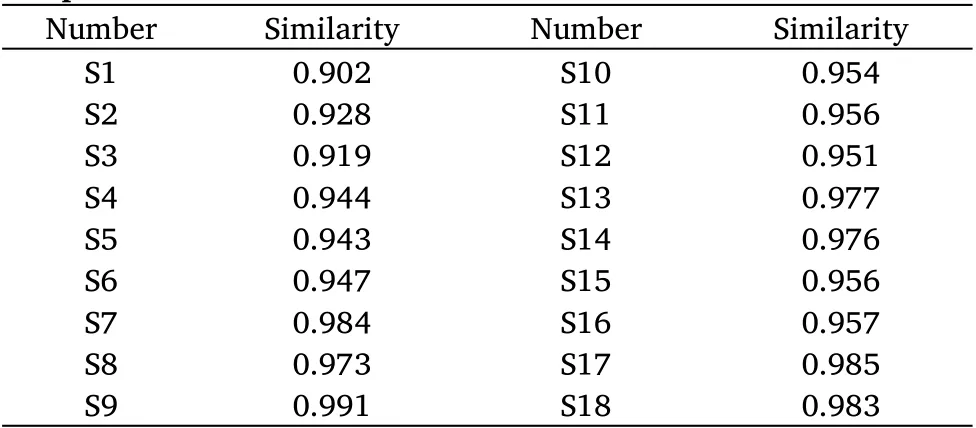
Table 3 Evaluation of the similarity of the fingerprint of the WPC samples
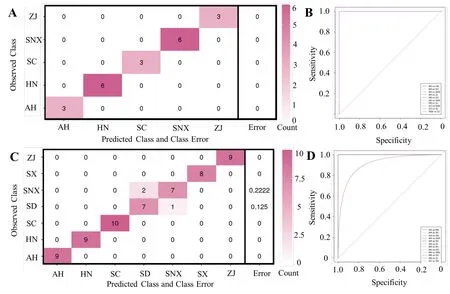
Figure 6 The confusion matrix (left) of FFNN for RC (A) and WPC (C) performance, the AUC (right) of FFNN for RC (B) and WPC (D)performance.The ordinate and abscissa represent the true regions and predicted regions respectively. The pink squares refer to the right detection.FFNN, feed-forward neural network; RC, raw cornus; WPC, wine-prepared cornus; AUC, area under curve; AH, Anhui Province; HN, Henan Province; SD, Shandong Province; SX, Shanxi Province; SNX, Shannxi Province; SC, Sichuan Province; ZJ, Zhejiang Province.
Conclusion
In this study, a trustworthy HPLC analytical method was provided to simultaneously determine the 7 components (gallic acid, 5-HMF,protocatechuic acid, morroniside, sweroside, loganin, and cornuside I)of cornus from different regions. The reference fingerprint of RC and WPC were established to calculate similarity between reference fingerprint and sample. This work showed that the reference fingerprint was successful to improve quality evaluation of cornus.During the processing of high temperature with wine, 5-HMF was produced by dehydration of glucose or fructose. Phenolic acids derivatives were hydrolyzed to generate gallic acid and protocatechuic acid. The C-4 position of -COOCH3was hydrolyzed to transform -COOH as more stable iridoid glycosides that cause the sharp decline of morroniside, loganin and cornuside I. In addition,FFNN model for RC and WPC provided the pattern classification of samples regions which contributed to distinguish true origins. This study provides a trustworthy method to evaluate the quality and distinguish the sources of cornus.
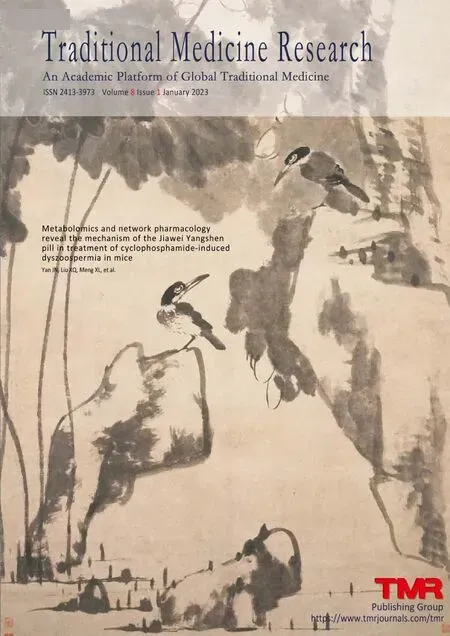 Traditional Medicine Research2023年1期
Traditional Medicine Research2023年1期
- Traditional Medicine Research的其它文章
- Forget the past,there is no future
- An updated study of traditional medicines to the era of 1,3,4 oxadiazole derivatives for malaria treatment
- Rutaecarpine attenuates monocrotaline-induced pulmonary arterial hypertension in a Sprague-Dawley rat model
- Metabolomics and network pharmacology reveal the mechanism of the Jiawei Yangshen pill in treatment of cyclophosphamide-induced dyszoospermia in mice
- Medicinal plants and phytomedicines are used to treat or prevent illnesses in Sudan:a review
